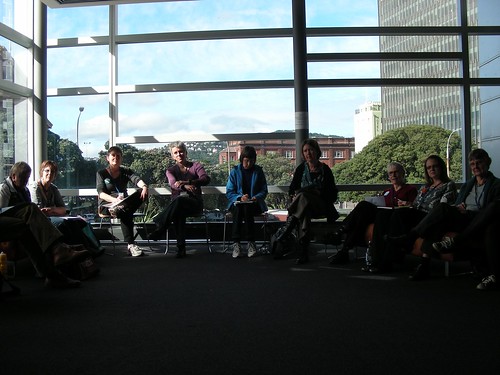As written in the previous post on the EYC unConference, everybody could propose a topic for a session and gather people to discuss it. After my initiated session on how to actually get people to use a community web site in which the attendees greatly participated and did not need a lot of facilitating, I went to a similar session. There the focus was on the use of social media, in particular Twitter and Facebook.
Online communities and social media
People saw the purpose of Twitter and Facebook differently and it always came down to finding where the people you want to reach hang out and picking them up from there.
Another important point that was raised was that not everybody is using social media and should not be forced to do so in order to join a community, but they should have alternative means for engagement. though that does not mean that the lowest common denominator should be chosen. It is worthwhile to educate community members about the possibilities of social media and offer them training so that they can become literate in its use.
Despite that, especially established community members should not be forced to go out of their way to continue engaging. Somebody came up with an analogy to a restaurant that was picked up by Joanna McCleod. When regular patrons come to a restaurant, they should not be made to go out again to find a flyer that is being distributed on Lambton Quay in order to be able to dine at that restaurant. They should still be able to just go inside without any detours.
The session attendees agreed that it is about the way of communicating and not necessarily the tool. Twitter and Facebook can change rather quickly in this day and age. So you may have to switch to another service. However, the idea of the social networking will persist. And you should not be afraid to pull the plug and discontinue using a tool when you realize that your community does not take to it. Your efforts can be used elsewhere more productively.

Web accessibility
Robyn Hunt talked about what everybody could do to improve their web sites to embrace accessibility. That does not only mean that people with disabilities can get more out of a web site, but it also means that the web site is improved for everybody as accessible web sites often also include looking at usability issues that might frustrate “regular” users as well.
I know that I have to improve the accessibility of my blog here, e.g. give meaningful alternative text and not just my picture caption and probably improve a whole bunch of other things that are normally hidden to the eye, but help people greatly who use screen readers.
Learning more about accessibility is a project on my ToDo list for which I will have to set aside a time and either participate in a workshop or read relevant texts.
One thing that particularly stuck in my head was that Facebook is not a good page in terms of accessibility because it is quite busy among things. However, when viewed on a smartphone, people with disabilities can participate as the content presented in the smartphone apps is basically clutterfree making it easier to use. Thus, though the service was not changed, a change of device suddenly enables a number of users to finally participate. And the internet offers independence and freedom to a great many people with disabilities as they can now get information that they had previously no access to and they can also engage in online conversations.
I cover the rest of the day in part 3 on the EYC Conference.
![]() This work is licensed under a Creative Commons Attribution-ShareAlike 4.0 International License.
This work is licensed under a Creative Commons Attribution-ShareAlike 4.0 International License.